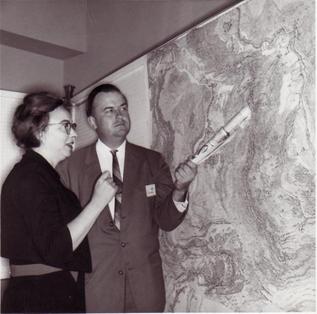Top Qs
Timeline
Chat
Perspective
Bruce C. Heezen
American geologist (1924–1977) From Wikipedia, the free encyclopedia
Remove ads
Bruce Charles Heezen (/ˈheɪzən/; April 11, 1924 – June 21, 1977) was an American geologist.[1] He worked with oceanographic cartographer Marie Tharp at Columbia University to map the Mid-Atlantic Ridge in the 1950s.
Remove ads
Biography
Summarize
Perspective
Heezen was born in Vinton, Iowa. An only child, he moved at age six with his parents to Muscatine, Iowa, where he graduated from high school in 1942. He received his B.A. from the University of Iowa in 1947. He received his M.A. in 1952 and a Ph.D in 1957 from Columbia University.

Heezen collaborated extensively with cartographer Marie Tharp. He interpreted their joint work on the Mid-Atlantic ridge and the East Pacific Rise as supporting S. Warren Carey's Expanding Earth Theory, developed in the 1950s,[2] but under Tharp's influence "eventually gave up the idea of an expanding earth for a form of continental drift in the mid-1960s." Tharp was Heezen's assistant while he was a graduate student and he gave her the task of drafting seafloor profiles.[3] When she showed Heezen that her plotting of the North Atlantic revealed a rift valley, Heezen initially dismissed it as "girl talk."[4] Eventually they discovered that not only was there a North Atlantic rift valley, but a mountain range with a central valley that spanned the earth.[4] They also realized that the oceanic earthquakes they had been separately plotting fell within the rift, a revolutionary theory at the time.[3] He presented this mid-ocean rift and earthquake theory as his own work at Princeton in 1957.[4] At that lecture, preeminent geologist Harry Hess[5] told Heezen, "Young man, you have shaken the foundations of geology!"[3][4]
Although Marie Tharp was later recognized and credited for her work on the Mid-Atlantic Ridge, it was Heezen who, at the time in 1956, put out and received credit for the discovery that was made, leaving off Tharp's name.
Heezen died of a heart attack in 1977 while on a research cruise to study the Mid-Atlantic Ridge near Iceland aboard the NR-1 submarine.[6]
Remove ads
Honors and awards
- 1964: Henry Bryant Bigelow Medal in Oceanography awarded by the Woods Hole Oceanographic Institution[7]
- 1973: Cullum Geographical Medal awarded by the American Geographical Society[8]
- 1977: Walter H. Bucher Medal awarded by the American Geophysical Union[9]
The Oceanographic Survey Ship USNS Bruce C. Heezen was christened in honor of him in 1999.[10]
Heezen Canyon is a large underwater canyon in the NW Atlantic, on the edge of the continental shelf.[11]
Heezen Glacier in Antarctica was named after him in 1977.[12]
Remove ads
References
External links
Wikiwand - on
Seamless Wikipedia browsing. On steroids.
Remove ads

